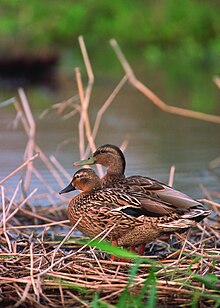| Hawaiian duck | |
|---|---|

| |
| Scientific classification | |
| Domain: | Eukaryota |
| Kingdom: | Animalia |
| Phylum: | Chordata |
| Class: | Aves |
| Order: | Anseriformes |
| Family: | Anatidae |
| Genus: | Anas |
| Species: | A. wyvilliana
|
| Binomial name | |
| Anas wyvilliana Sclater, PL, 1878
| |
The Hawaiian duck (Anas wyvilliana) or koloa is a species of bird in the family Anatidae that is endemic to the large islands of Hawaiʻi. Taxonomically, the koloa is closely allied with the mallard (A. platyrhynchos).[3] It differs in that it is monochromatic (with similarly marked males and females) and non-migratory.[4] As with many duck species in the genus Anas, Hawaiian duck and mallards can interbreed and produce viable offspring, and the koloa has previously been considered an island subspecies of the mallard (Anas platyrhynchos).[4] However, all major authorities now consider this form to be a distinct species within the mallard complex.[3][4][5][6] Recent analyses indicate that this is a distinct species that arose through ancient hybridization between mallard and the Laysan duck (Anas laysanensis).[7] The native Hawaiian name for this duck is koloa maoli (meaning "native duck"), or simply koloa. This species is listed as endangered by the IUCN Red List of Threatened Species, and its population trend is decreasing.[1]
- ^ a b BirdLife International. (2023). "Anas wyvilliana". IUCN Red List of Threatened Species. 2023: e.T22680199A221561950. doi:10.2305/IUCN.UK.2023-1.RLTS.T22680199A221561950.en. Retrieved 2 September 2024.
- ^ "Anas wyvilliana. NatureServe Explorer 2.0". explorer.natureserve.org. Retrieved 24 April 2023.
- ^ a b Cite error: The named reference
ref9was invoked but never defined (see the help page). - ^ a b c Pyle, RL; Pyle, P (2009). The Birds of the Hawaiian Islands: Occurrence, History, Distribution, and Status. B.P. Bishop Museum, Honolulu, HI, U.S.A. Version 1 (31 December 2009).
- ^ IOC. "IOC World Bird List v.5.2". Retrieved 2015-05-27.
- ^ BirdLife International. "Hawaiian Duck Anas wyvilliana". Retrieved 2024-09-02.
- ^ Lavretski; et al. (2015). "Genetic admixture supports an ancient hybrid origin of the endangered Hawaiian duck". Journal of Evolutionary Biology. 28 (5): 1005–1015. doi:10.1111/jeb.12637. PMID 25847706.

